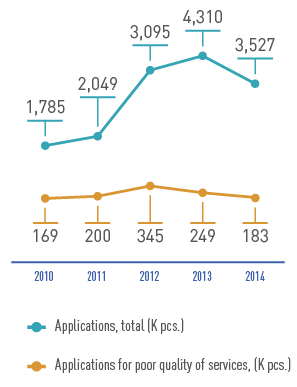In accordance with strategic goals, set to JSC ROSSETI by the Government, and taking into account current requirements and challenges faced by the electric power industry, goals and priorities of JSC ROSSETI are defined in the following areas:
 Reliability
Reliability
Ensure the reliable and uninterrupted power supply, energy security
- decrease of number and duration of power outages (accidents)
- decrease electricity underdelivery to customers
- management the condition of electric grid facilities
- assurance compliance of the facilities, putting into operation, with reliability and safety requirements
- development of certification of equipment system, materials and systems as incoming control of technical data of the equipment applied in SDC's objects
- development of technical inspection and supervision in JSC ROSSETI
ROSSETI’s Main Results of Securing a Reliable and Uninterrupted Power Supply in 2014
In order to secure a reliable and stable power supply in all regions of ROSSETI’s operations, the Company continued in 2014 to systematically work toward lower accident rates and achieved appreciable results in this area.
In the reporting period, all branches of ROSSETI’s subsidiaries and dependent companies achieved their planned targets of the Average Outage Duration Indicator. 25 companies/branches achieved substantial improvement to the Average Outage Duration Indicator.
Overall, in the ROSSETI Group’s networks rated 6 kV and above in the reporting period, the specific accident rate was decreased by 16%, while the average duration of power outages was decreased by 20.5%
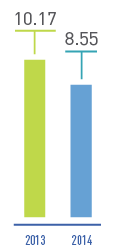
Repair Program
The principal goal of ROSSETI’s repair program is to secure a reliable and high-quality electricity supply for consumers, including households and large industrial customers, and ensure the accident-free operation of facilities in the heat deficit period.
In 2014, expenses associated with repairs done inhouse or by contractors to substations and overhead lines, buildings and structures, and other equipment totaled RUB 22.5 rubles and RUB 14.3 rubles respectively. The completion of the repair program in the reporting year is 107%
The 2014 repair program related to the following types of equipment:
- substations rated 35 kV and above;
- overhead lines rated 35 kV and above;
- buildings and structures;
- protective relays and automatic emergency control systems;
- dispatching and process control equipment;
- measuring instruments, measuring systems, and energy metering systems;
- distribution networks rated 0.4/6/10 kV;
- mechanized equipment and vehicles;
- automated control systems;
- safety equipment.
The repair program included measures to implement regulatory instructions and target-oriented programs to:
- enhance the operating reliability of power equipment and overhead lines;
- prepare electric grid facilities for operation in the heat deficit period and lightning storm season;
- ensure reliable operation in the floodwater period;
- carry out instructions issued by supervisory authorities.
The timely implementation of the repair program is the key to successful operation in the heat deficit period. Overall, the ROSSETI Group’s accident rates in networks rated 6 kV and above in the 2014/15 heat deficit period went down by 25%. Accident rates in networks rated 110 kV and above decreased by 22% in the same period.
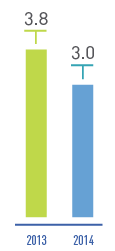
Compared with the previous reporting period, the number of massive power outages grid facilities due to adverse weather conditions decreased from 127 to 85, with the average power restoration time reduced from 3.8 hours to 3.0 hours, i.e. by about 20%.
Throughout the period of preparations for winter peak loads, ROSSETI takes comprehensive measures to improve electricity supply reliability: the cleanup and widening of clearings, repairs to primary equipment, skill improvement, and grid-wide exercises aimed at enhancing interaction among the ROSSETI Group’s electric grid companies. This makes it possible to send personnel and resources to adjacent areas for accident recovery work as soon as possible.
In planning the production program, the ROSSETI Group continues to increase the share of repairs carried out on the basis of the assessment of technical condition with respect to equipment of substations and elements of overhead lines, and according to the results of technical examination, diagnostic inspections, tests, and measurements. For instance, in addition to standard major repairs to transformers and intermediate repairs to circuit breakers medium repair, the following work was done in 2014:
- high-voltage bushings were replaced by bushings with solid insulation;
- on-load tap changers were repaired;
- for circuit breakers rated 35–110 kV, hollow porcelain insulators were replaced, new modern actuators were installed, and high-voltage bushings, arc chutes, and internal tank insulation were replaced.
Reducing Accident Rates
In the reporting period, ROSSETI’s subsidiaries and dependent companies recorded and investigated 122,856 process failures in networks rated 6 kV and above (13% down from 2013), including 15,995 process failures in networks rated 110 kV and above (6% down from 2013).
The system of recording electric grid facilities’ process failures in ROSSETI SDCs in 2014 was governed by the following regulations:
- Rules for Investigating into the Causes of Accidents in the Electricity Industry, approved by Resolution of the Government of the Russian Federation No. 846 of October 28, 2009, whereby all process failures in any network of 6 kV or above are classified as accidents;
- Guidelines for Calculating the Level of Reliability and Quality of Supplied Goods and Rendered Services for the Organization Managing the Unified National (All-Russian) Electric Grid and Territorial Grid Organizations, approved by Order of the Ministry of Energy of the Russian Federation No. 718 of October 14, 2013.
In order to expand the system of assessing the performance of its electric grid facilities on the basis of accident information, including making it possible to calculate globally applied electricity supply reliability indicators, ROSSETI developed and introduced into its subsidiaries and dependent companies an up-to-date software system for recording process failures (Avariynost)
The criterion for measuring reliability, based on the generally accepted international indicators and under the documents listed above, is the duration of power outages. The equivalent of the above-mentioned indicator for ROSSETI’s subsidiaries and dependent companies is the Average Outage Duration Indicator specified by Regional Energy Commissions. All ROSSETI SDCs achieved their planned targets in this area.
According to process failure investigation reports, the main causes of reliability failures in electric grids (as a percentage of the total number of process failures/accidents) are as follows:
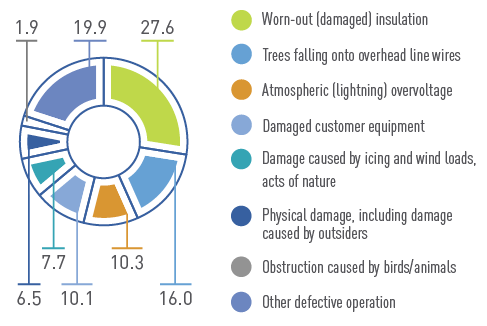
ROSSETI SDCs continued in 2014 to work under the target-oriented multiyear programs to:
- widen narrow clearings;
- replace oil circuit breakers rated 6–110 kV with modern vacuum circuit breakers and SF6-insulated circuit breakers;
- replace surge arresters rated 6–110 kV with overvoltage suppressors, etc.
In 2014, measures were developed and carried out to prevent consistent failures of overhead lines.
Effective production operations in 2014 reduced process failures caused by trees falling onto overhead line wires, malfunctions and false operation of relay protection, and other defective operation.
Reducing Electricity Underdelivery
One of the principal parameters that can be influenced by an electric grid company in relation to calculating this indicator is the duration of process failures resulting in power outages. For comparison, the diagram below shows information by company about the average duration of process failures related to power outages.
The ROSSETI Group’s total average duration of process failures in 2014 is 20.5% down from 2013.
Overall, the reliability indicators were substantially improved by the timely and high-quality implementation of the capital investment and repair programs and by the comprehensive modernization and technical upgrading of electric grids.
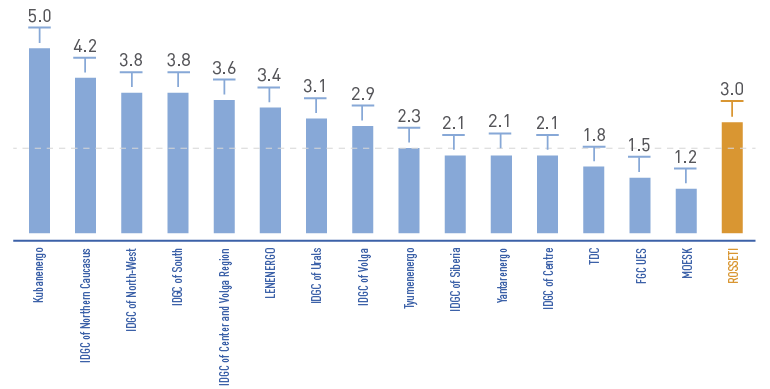
Energy Conservation and Energy Efficiency Enhancement
Energy efficiency enhancement is one of the principles of increasing the competitiveness of the Russian economy. In this regard, one of the ROSSETI Group’s priorities is to implement energy conservation and energy efficiency enhancement measures aimed at the efficient use of energy resources and the reduction of network electricity losses. To this end, ROSSETI formulated and implement 16 energy conservation and energy efficiency enhancement programs of subsidiaries and dependent companies (interregional distribution grid companies and FGC UES; hereinafter, “SDCs”) and 7 programs of ROSSETI SDCs’ subsidiaries.
In 2014, the Board of Directors ROSSETI approved the Innovative Development, Energy Conservation, and Energy Efficiency Enhancement Policy, defining a set of the principles and rules of measures aimed at energy conservation and energy efficiency enhancement.
The energy conservation targets are as follows:
- reduce energy losses;
- reduce specific energy consumption for business needs;
- provide modern electricity meters for the retail market.
In 2011, each interregional distribution grid company formulated its energy conservation and energy efficiency enhancement program and had it approved by the board of directors
The Programs include the following production subprograms:
- program of organizational and production engineering measures to reduce electricity losses;
- program to reduce the consumption of energy resources for production and business needs;
- program to renew electric grid equipment;
- program of the long-term development of electricity metering systems in the retail market.
Based on interregional distribution grid companies’ programs, the Consolidated Energy Conservation and Energy Efficiency Enhancement Program for 2011–2016 was approved and brought into operation.
Jointly with the Ministry of Energy of the Russian Federation, ROSSETI analyzed in 2014 the existing programs and factors affecting the efficiency of their implementation. Based on the analysis results, the Company drew up the following documents:
- Regulations for the Formation of Energy Conservation and Energy Efficiency Enhancement Programs of Subsidiaries and Dependent Companies of ROSSETI;
- Certificate of the Energy Conservation and Energy Efficiency Enhancement Program (formats);
- Instruction on the Formulation of the Energy Conservation and Energy Efficiency Enhancement Program of Subsidiaries and Dependent Companies of ROSSETI.
This approach to the formulation of the programs was reviewed and approved by the Board of Directors of ROSSETI.
The main differences from the existing energy conservation program are as follows:
- Targeted measures were identified.
- The metering system development program was separated from the energy conservation program.
- The energy conservation program was given priority over the capital investment program.
- Efficiency measures were ranked.
- Energy efficiency benchmarking was provided for ROSSETI’s subsidiaries and dependent companies.
- The expanded list of targets was made.
- New formats were developed in accordance with the above-mentioned requirements and instructions on completion.
- The explanatory note form and the measure certificate form were added.
- Approaches were synchronized with the methodology of preparing the capital investment programs.
In view of the new approach, the Unified Energy Conservation and Energy Efficiency Enhancement Program of ROSSETI was developed, decomposing the ROSSETI electric grid sector’s efficiency for SDCs. The Program will form the basis for SDCs’ programs.
Detailed information about the energy resources used for business needs and the results of measures to reduce the consumption of energy resources can be found in Appendix 11 to the Annual Report
 Modernization
Modernization
Implementation of the Innovative Development and R&D Programs
ROSSETI successfully continued in 2014 to carry out the Innovative Development Program for distribution and transmission grids. The Innovative Development Program of ROSSETI consists of two separate parts:
- The Company’s Innovative Development Program for 2011–2016 implemented in subsidiaries and dependent companies (interregional distribution grid companies) of ROSSETI.
- The Innovative Development Program developed and implemented in FGC UES for transmission grids.
The Programs involve 17 subsidiaries and dependent companies of ROSSETI, operating in 78 Russian regions: interregional distribution grid companies and FGC UES.
The Programs are aimed at achieving the strategic goal of the electric grid sector: securing the reliable, high-quality, and affordable energy supply for customers on a long-term basis by building a network infrastructure
that is maximally efficient and conforms to international standards, including using advanced innovative approaches, technologies, and solutions.
The Innovative Development Program focuses on:
- ensuring the development and introduction of advanced technology and creating the conditions for carrying out innovation projects;
- automating the operation of electric grid facilities;
- implementing pilot projects and solutions;
- building up an efficient management system for innovative development and streamlining the business process management system;
- developing and introducing new energy efficiency technology and making use of modern engineering solutions aimed at energy efficiency enhancement;
- developing and improving electricity metering systems;
- employing up-to-date quality control methods for the management system;
- carrying out the Research and Development (R&D) Program;
- minimizing the adverse impact of electric grids on the environment and public health;
- improving the system of mutually beneficial collaboration with innovative small and medium-sized businesses and carrying out projects and R&D activities aimed at the development of innovative technologies, products, and services;
- creating the conditions for the development of employees’ competencies in innovation, research, and engineering by improving personnel training programs and providing the Company’s employees with targeted training, advanced training, retraining, and pre-evaluation training.
An important result of accomplishing the key goals of the Innovative Development Program is the practical use of solutions and technologies, namely focused and comprehensive projects, with their subsequent commercialization.
In 2014, ROSSETI developed and approved the Innovative Development, Energy Conservation, and Energy Efficiency Enhancement Policy. The Policy defines the principles and rules of conduct for the Company’s functional areas with respect to innovative development, energy conservation, energy efficiency enhancement, and environmental protection. The Policy contains goals and objectives and specifies targets and implementation mechanisms for the above-mentioned functional areas.
Implementation of the R&D Program
A significant part of the Innovative Development Program is the Research and Development (R&D) Program. The formulation of the R&D Program takes account of the challenges faced by the electric grid sector and takes into consideration the promising innovative areas of R&D in line with the innovative development programs of ROSSETI’s subsidiaries and dependent companies.
The R&D Program contains measures to develop breakthrough technologies aimed at creating fundamentally new products, techniques, and methods and covers practical areas of improving existing technologies.
In 2014, proposals were invited for the R&D Program, received proposals were examined, and the R&D topics that had previously been approved but remained without implementation on a contractual basis were updated; the letter of information (No. BR-138 dated January 13, 2014) and the lists of topics approved for inclusion in the R&D Program were prepared, formally submitted, and posted on ROSSETI’s corporate website. In furtherance of its efforts to improve the R&D management system, ROSSETI formulated and approved the Regulations for the Introduction of Innovative Solutions into the company. This document sets forth the procedure for ROSSETI’s and its SDCs’ measures to organize the introduction of innovative and/or high-technology products and deliverables of ROSSETI and SDCs under the R&D Program.
|
SDCs |
Project |
Result |
|---|---|---|
|
FGC UES |
Developing and producing a prototype of an SF6-insulated supply transformer rated 220 kV and 63 MVA |
A prototype of one phase of an SF6-insulated transformer rated 220 kV and 63 MVA was created and tested. |
|
Developing and producing an industrial prototype of a thyristor-controlled phase shifter for a specific facility of the Unified National (All-Russian) Electric Grid |
An industrial prototype of a thyristor controlled phase shifter for a facility of the Unified National (All-Russian) Electric Grid was developed and produced. |
|
|
Designing industrially aesthetic single-circuit and double-circuit towers for overhead lines rated 220 kV |
A set of documents was developed to enable industrially aesthetic single-circuit and double-circuit towers for overhead lines rated 220 kV to be used under overhead line construction and rehabilitation projects. |
|
|
Setting up the Digital Substation Test Field. Prototyping and testing the Digital Substation software and hardware system |
Russia’s first Digital Substation was set up and is simultaneously used as a test field for various solutions. |
|
|
Building a system of “hot spot” condition monitoring based on temperature and current sensors for overhead lines rated 110–220 kV |
A system was built to assess the actual condition of specific overhead line elements to do the condition monitoring of overhead lines, plan repairs, and improve overhead line reliability in electricity transmission and distribution. |
|
|
IDGC of Center |
Developing a system of dynamic compensation for reactive loads resulting from abrupt changes in network loads with the capability to record network loads and generate and upload event reports |
A mathematical model was built, an automation algorithm and software prototype were developed, the software prototype was tested and debugged, a prototype of a dynamic compensation device was developed and produced, the prototype of a dynamic compensation device was tested at a facility of Tulenergo, a branch of IDGC of Center and Volga Region |
|
Preparing a concept of using Smart Grid elements and individual transformer substations (one transformer for one house) to build an innovative electricity network rated 0.4–6 (10) kV in a particular locality |
A 390-meter pilot section of the distribution network in Bogorodsk, Nizhni Novgorod Region, was put into test operation, using 10 individual transformer substations rated 0.55/0.23 kV and 0.95/0.4 kV combined with the suspension of networks rated 0.4 and 0.95 kV. |
|
|
Developing a lightning protector based on a multi-chamber system: a ShFMK-20 multi-chamber surge arrester based on porcelain pin insulators and their modifications for overhead lines rated 6–20 kV |
47 insulating surge arresters were put into test operation in a 3-kilometer section of 10-kV overhead line No. 1004 of Cherkutino Substation. |
|
|
Kubanenergo |
Developing a system of field-based supply transformer insulation testing using a system of partial discharge monitoring |
A system of transformer insulation testing was created and tested at five of Kubanenergo substations rated 110 kV (110-kV Pochtovaya Substation, 110 kV Staro Shcherbinovskaya Substation, 110-kV Shcherbinovsky s/s Substation, 110-kV Zhuravskaya Substation, 110-kV Lebedi Substation) without interrupted substation operation for analyzing the existence and increasing intensity of partial discharges |
|
Tyumenenergo |
Developing a frequency-dependent resistor for high-frequency overvoltage suppression |
Three prototypes of frequency-dependent resistors were installed and put into test operation at Noyabrsk Electricity Networks, a branch of Tyumenenergo (110-kV Sugmutskaya Substation). |
|
Developing, producing and putting into use a digital protective relay for electrical installations without control current sources |
24 prototypes of TOR 120 factory-assembled relay protection devices were put into test operation at 110/10-kV Yuzhny TPO Substation of Tyumen Distribution Networks, a branch of Tyumenenergo. |
|
|
IDGC of Northern |
Developing a technique and device for the remote detection of damaged insulators of overhead lines rated 6–35 kV |
A prototype was made for remote high-voltage fault localization for overhead line insulation. |
|
IDGC of Centre |
Designing polygonal steel anchor towers for overhead lines rated 0.4 kV |
A single-pole polygonal steel anchor tower with technical and economic characteristics higher than those of its equivalents was developed. |
|
IDGC of South |
Creating and putting into test operation a selective protection set using modern hardware components for protection from line-to-ground short circuits in compensated and uncompensated networks rated 6–35 kV based on detecting line-toground short circuits in transitional and established processes |
An individual protector and centralized selective annunciator were developed; the equipment was test-operated. |
|
IDGC of Volga |
Developing and producing a static dry arc-control device for capacity current compensation in networks rated 6–10 kV |
A prototype of ATDS dry power equipment with improved capability was made for capacity current compensation for short circuits to ground in distribution networks rated 6–10 kV. |
|
Developing a set of diagnostic equipment for remote insulation fault localization for substations rated 35–220 kV |
A prototype of an insulation fault localization system for substation equipment was installed and adjusted at a substation. |
|
SDCs |
Projects |
|---|---|
|
IDGC of Siberia |
|
|
IDGC of Northern Caucasus |
|
|
LENENERGO |
|
|
MOESK |
|
|
IDGC of North-West |
|
| Kubanenergo |
|
| IDGC of Centre |
|
| IDGC of Urals |
|
| IDGC of Volga |
|
| Yantarenergo |
|
Introduction means a full range of activities carried out by ROSSETI and its subsidiaries to bring innovative solutions into use by electric grid facilities. These activities include keeping the Register of Innovative Solutions Recommended for Use by Subsidiaries and Dependent Companies of ROSSETI, setting the target for an increase in services provided using innovative solutions, and introducing such solutions into facilities under repair and capex programs.
In 2014, the Company developed the Concept of Managing the Intellectual Property of ROSSETI and Subsidiaries and Dependent Companies of ROSSETI, approved by the Management Board of ROSSETI.
As part of carrying out the action plan to implement the intellectual property management system, ROSSETI and SDCs initiated the formulation of internal regulations and orders relating to intellectual property, innovation, and invention management. In addition, the Company plans to create an IT system for intellectual property management.
To find a long-range solution to developing the R&D management system, ROSSETI and SDCs are considering setting up the centralized Foundation for Research, Development, and Innovation Support and the Center for Technology Monitoring and Transfer.
The R&D Foundation will provide further impetus for the development of R&D by making it possible to carry out long-term projects with confirmed financial backing from the R&D Foundation, distribute R&D deliverables to all SDCs, and co-finance large-scale projects jointly with sectoral and governmental foundations.
Detailed information about the R&D Program can be found on the corporate website at http://www.rosseti.ru/eng/investment/policy/rd/
Development of the EV Charging Station Infrastructure
As ignificant project in 2014 was ROSSETI’s participation in the nationwide program to develop the electric vehicle charging station infrastructure. Carried out in regions where ROSSETI’s SDCs have operations, the project has the high economic potential for the energy industry and is environmentally friendly.
The main achievements in the development of the EV charging station infrastructure in the reporting period are as follows:
- Creation of an ultra-fast charging station for electric public transportation (electric buses) within the responsibility of MOESK;
- Development of engineering solutions related to combining conventional distribution grid facilities with a charging infrastructure (transformers of a medium-voltage and low-voltage network) within the responsibility of IDGC of Centre;
- Development of engineering solutions related to combining a charging infrastructure with high-capacity lithium-ion storage batteries for connections in limited network capacity and/or energy supply category conditions within the responsibility of IDGC of Center and Volga Region;
- Launch of the first charging stations in Saint Petersburg and Yaroslavl as part of developing Russia’s EV charging station infrastructure;
- Creation of a smart infrastructure in Skolkovo (construction of a charging station infrastructure (network) for electric vehicles (big and small electrobuses) (Skolkovo Innovation Center, Moscow Region). Five charging stations came into operation;
- Creation of a charging infrastructure in New Moscow (construction of a charging station infrastructure (network) for electric vehicles (big and small electrobuses) in New Moscow);
- Launch of the city’s first electrobus route in Yaroslavl within the responsibility of IDGC of Centre.
Development of Technical Standard Documents (TSD)
In 2014, ROSSETI provided resources for establishing the Subcommittee on Electric Grids (Transmission and Distribution) of the Technical Committee on Electricity Industry Standardization working in the area of national standardization in accordance with Order of the Federal Agency for Technical Regulation and Metrology of the Russian Federation No. 1322 of September 5, 2014, “On the Reorganization of the Technical Committees on Electricity Industry Standardization.”
ROSSETI’s active participation in the Subcommittee made it possible to formulate proposals for the plan to develop national and interstate standards for 2015. The plan includes 15 documents, 11 national standards, and four interstate standards with financial backing; the formulation of action plans for national standardization for 2016 and 2017 is nearing completion
ROSSETI’s technical regulation system is intended to accomplish the following objectives:
- Ensure Russia’s energy security and strengthen its national economy;
- Strengthen scientific, technical, economic, and industrial relations with foreign countries;
- Improve the quality of domestic electrical equipment;
- Transfer smart technology;
- Place barriers to the penetration of low-quality electrical equipment to the sector and ensure import substitution for foreign equivalents;
- Secure the reliable and effective operation of the electric grid sector.
ROSSETI and its SDCs achieved the following results in 2014:
- technical standard documents that are in wide use by SDCs in their activities were collected. At present, the collection consists of more than 950 documents;
- the classifier of utilized equipment and processes describing SDCs’ business operations was developed;
- the plan to develop corporate, national, and interstate standards for 2015–2017 was formulated. At present, the draft plan includes more than 400 documents;
- the issue of 19 standards of ROSSETI and 24 standards of SDCs was completed or is nearing completion; two interstate standards and six national standards were submitted for review; work started on revising the industry’s basic document “Scope and Standards of Electrical Equipment Tests.”
Setting up the Federal Testing Center
The year 2014 saw the beginning of setting up Russia’s Federal Testing Center (FTC), one of its founders being ROSSETI. FTC will have all necessary equipment and will focus primarily on testing high-voltage equipment. The establishment of the Federal Testing Center is one of the most important steps toward the development of the country’s electric grid sector.
In April 2014, the Board of Directors of ROSSETI approved the Concept of Setting up the Federal Testing Center, which defines FTC’s tests and laboratories, the total amount of investment, the intended financing structure, and investment performance indicators. On October 16, 2014, the Russian Government issued the directive to establish Public Joint-Stock Company Federal Testing Center (PJSC FTC). On November 21, 2014, the company was registered in Saint Petersburg.
On December 15, 2014, the concept of developing the Federal Testing Center was submitted for consideration by the Board of Directors of PJSC FTC, resulting in the approval of the workforce structure for the initial period of operation. In 2014, the contract was awarded for the development of project documents related to setting up FTC, including:
- developing basic technical solutions for facilities under construction;
- determining power consumed by FTC from the external power grid;
- determining the composition of test laboratories and benches;
- considering the creation of a network test bench;
- estimating the total value of FTC;
- developing the external electricity supply scheme of FTC.
The project involves building a complex of 20 laboratories, including high-voltage equipment test benches, a climatic test chamber for electrical installation with test temperatures ranging from +65 to -70 °C, and electromagnetic-compatibility and mechanical-stress test laboratories
FTC will make it possible to conduct investigative tests of prototypes and pre-production models of new electrical products, while the industry will be provided with the development of domestic manufacturers of equipment rated over 110 kV.
Setting up FTC will considerably shorten the period from developing new domestic technologies to bringing them into use. In addition, the test facilities available in the country will create the conditions for avoiding additional transportation costs and customs fees and duties associated with the delivery of equipment to and from foreign testing centers, which will limit increases in the cost of equipment and provide strong support for the strengthening and development of domestic manufacturers.
ROSSETI expects that the creation of the Federal Testing Center will be complete in December 2017.
Import Substitution
The development of the Russian electric power industry is currently aimed at attaining the goals of the country’s economic modernization and diversification. In 2014, the Government of the Russian Federation put forward a whole range of legislative initiatives to carry out the import substitution policy. The foreign economic situation in 2014 around the Russian Federation is currently a key driver of speeding up and expanding import substitution in all key areas of economic development, including the electricity industry.
Import substitution is regarded as a mechanism for the innovative development of the energy and related industries and as a driver of developing domestic power plant engineering, electrical engineering, and sectoral and fundamental science to ensure Russia’s energy and economic security
In this connection, ROSSETI identified two key areas of import substitution policy implementation:
Ensuring industrial growth in the Russian economy through the development of domestic manufacturers’ competencies and technology transfer:
- identify the modern and innovative technologies necessary for the implementation of ROSSETI’s strategy and technical policy and transfer them at the desired level of production and R&D localization;
- create the conditions for providing the electric grid sector with domestically made modern equipment, including ROSSETI’s direct involvement in designing new and up-to-date types of electrical equipment.
Improving the competitiveness of the Russian energy sector through the development of engineering capabilities for power plant engineering inside the country:
- create the legislative conditions for giving preference to the use of domestically made equipment and component parts;
- establish priorities with respect to domestic substitutes for imported equipment to build up a system of long-range conditions for the production of domestic equivalents;
- geographically diversify the supply of equipment and component parts that have no domestic equivalents.
As instructed by the Presidential Commission for Strategic Development of the Fuel and Energy Sector and Environmental Security of the Russian Federation (Minutes of the Meeting No. A4-26-368 of June 4, 2014), ROSSETI formulated and carries out the Action Plan to Reduce Import Dependence in the Electric Grid Sector of the Russian Federation. The Action Plan includes the following key measures:
- develop and implement the comprehensive Import Substitution Program for ROSSETI subsidiaries for the period until 2019;
- extensively cooperate with domestic manufacturers in order to create the conditions for achieving expanded production and improved product quality;
- centralize equipment purchases for ROSSETI subsidiaries in order to unify technical and design solutions and maximize the use of domestic equivalents;
- minimize the use of imported equipment and materials in the course of preparing design solutions;
- create the conditions for entering into long-term supply contracts with domestic manufacturers for guaranteed quantities in order to use state-of-the-art technology and maximize production localization for equipment and component parts.
ROSSETI entered into an agreement with its technological partner Rostec for import substitution in the electric grid sector
ROSSETI and Rostec signed the Road Map and established the Coordination Council on setting up the Common Competence Center for the manufacture and supply of import-substituting equipmentfor the electric grid sector.
In 2014, in the presence of President of the Russian Federation Vladimir Putin and President of the People’s Republic of China Xi Jinping, ROSSETI and SGCC signed the Strategic Cooperation Agreement to set up a Russia-based joint venture in order to modernize electric grid facilities and attract new technology and investment, which will facilitate the diversification of supplied equipment and component parts.
An important area of import substitution is also to increase the localization of foreign manufacturers’ production. Aiming to do production localization in Russia, the Company signed strategic cooperation agreements with Hyundai Heavy Industries, ABB, and Alstom in 2014. In order to optimize costs of localized products, ROSSETI also works to reduce customs duties on imported component parts. For instance, import duties on component parts for factory-assembled switchgear were abolished (reduced to zero) in 2014.
ROSSETI is active in cooperating with Russian regional authorities to encourage local manufacturers to supply products to its facilities. In 2014, the Company entered into a cooperation agreement with the Sverdlovsk Region Government and signed a road map with the Tomsk Region Government.
ROSSETI has plans to accelerate import substitution and decrease the share of imported products used by electric grids to 14% by 2020
ROSSETI’s comprehensive Import Substitution Program will be considered by the Board of Directors in the first half of 2015 and should become one of the key instruments for implementing the Long-Term Development Program of ROSSETI.
The large-scale import substitution project for the electric power industry will be facilitated by Federal Law No. 488-FZ “On Industrial Policy in the Russian Federation” developed by the Ministry of Industry and Trade of the Russian Federation and enacted on December 31, 2014.
 Efficiency
Efficiency
Enhancing the operating efficiency of electric grids as related to:
- operating activities,
- investing activities,
- energy efficiency,
- import substitution,
- innovative development,
- environmental security,
- institutional transformations improving the efficiency of the electric grid sector as a whole,
- anti-corrupt practices,
- internal control, risk management, and internal audit.
Cost Management
One of the key objectives of the Company’s management is to increase the operating efficiency of ROSSETI SDCs. The targets of improving the operating efficiency of the electric grid sector are set by the Strategy for Development of the Electric Grid Sector of the Russian Federation approved by Ordinance of the Government of the Russian Federation No. 511r of April 3, 2013.
Key Targets of the Strategy for Development of the Electric Grid Sector of the Russian Federation
- reduction of operating expenses by 15% by 2017, adjusted for inflation, compared with 2012, per unit of maintained electrical equipment
- reduction of specific investing expenses by 30% compared with 2012 (in rubles per physical unit: kilometers, MVA)
- reduction of electricity losses by 11% by 2017 compared with 2012
In order to attain the Strategy’s targets of reducing operating expenses, ROSSETI formulated the Economic Policy approved by the Board of Directors and the Operating Efficiency Management Program for 2014–2017.
The Company’s Economic Policy defines the priorities, goals, and activities of the ROSSETI Group to improve the efficiency of the electric grid sector’s operating and financing activities, ensure long-term and transparent tariff regulation, keep a balance between the interests of electric grid companies and customers, and make the entire industry more attractive to investors.
The Operating Efficiency Management Program is an instrument for improving the ROSSETI Group’s operating efficiency, aimed at minimizing the consumption of resources without being detrimental to the reliability, quality, and accessibility of power supply.
The Operating Efficiency Management Program is in line with the Action Plan to Limit the Ultimate Cost of Goods and Services of Infrastructure Companies (Instructions of the Prime Minister of the Russian Federation No. 6732p-P9 of November 11, 2013).
The target of the Operating Efficiency Management Program is to optimize costs and efficiently manage cash to meet the Company’s challenges amid restrictions on tariff growth rates
The main areas of the Program are as follows:
- improve operating efficiency (reduce general and administrative expenses, increase workforce productivity, optimize the structure of repairs, reduce network electricity losses, improve the efficiency of receivables management, introduce the benchmarking system, etc.);
- improve the efficiency of investing activities (reduce specific investing expenses by 30% compared with 2012, conduct the price and technological audit of investment projects worth over 1.5 billion rubles, develop the institution of prioritizing capital investment projects, import substitution, increase the share of purchases using the auction procedure of decreasing prices (reverse auctions), create a centralized electronic trading floor, etc.);
- improve the efficiency of financing and other non-operatizing activities (take measures aimed at stabilizing the financial condition and maintaining credit ratings, optimize borrowing costs, find favorable financing terms, establish and monitor limits on the debt position, sell noncore assets, etc.).
The implementation of the ROSSETI Group’s Operating Efficiency Management Program resulted in 2014 in cutting operating expenses by 13.5%, or 23.1 billion rubles compared with 2012, adjusted for inflation
In addition, in order to achieve the target set by the Strategy as related to reducing specific operating expenses and implement Directive of the Government of the Russian Federation No. 2454P-13 of April 23, 2014, regarding the reduction of general and administrative expenses by at least 15% of their actual value in 2013, the Optimization Programs for General and Administrative Expenses were developed for the ROSSETI Group, involving measures in the following areas:
- optimizing the management structures;
- improving the staff motivation system based on key performance indicators;
- optimizing the costs of external services (optimizing expenses associated with repairs using outside organizations’ services, reducing travel expenses, decreasing expenses associated with voice and data communication services, bringing down expenses associated with information services, etc.).
In 2014, the ROSSETI Group cut general and administrative expenses by 17.5%, or 9.5 billion rubles compared with 2013
The efficient use of resources and cash management resulting from the implementation of the Operating Efficiency Management Program in 2014 enabled the Company to achieve the long-term targets set by the Strategy and implement the Government’s policy on enhancing the efficiency of natural monopolies.
Achievements and Results in the Reduction of Electricity Losses in 2014
The ROSSETI Group’s actual electricity losses totaled 75,229.955 million kWh, or 9.52% of electricity delivered to networks. Compared with 2013, electricity losses decreased by 1,056.4 million kWh, or 0.14 percentage point. In accordance with the directive of the Government of the Russian Federation (No. AT-15120/08 of December 31, 2014), the planned level of electricity losses (key performance indicator, KPI) for ROSSETI was 9.63% for 2014. The KPI decreased in 2014 by 0.11 percentage point. The reduction in electricity losses is largely due to carrying out the measures contained in long-term energy conservation and energy efficiency enhancement programs approved by the boards of directors of ROSSETI SDCs.
The economic effect of measures to reduce electricity network losses totaled 5,219.8 million rubles in 2014
|
Item |
Measures |
Effect, million kWh |
Effect, million rubles |
|---|---|---|---|
|
1 |
Targeted measures to reduce electricity network losses in the Unified National (All-Russian) Electric Grid (FGC UES) |
96.10 |
258.86 |
|
2 |
Total for distribution grids |
2,913.40 |
4,960.96 |
|
2.1 |
Organizational measures in distribution grids |
1,762.85 |
3,001.80 |
|
2.2 |
Technical measures in distribution grids |
218.42 |
371.93 |
|
2.3 |
Measures to improve electricity billing and metering systems in distribution grids |
932.13 |
1,587.23 |
|
|
TOTAL |
3,009.50 |
5,219.82 |
Procurement activities
Results of 2014
- The share of purchases through electronic trading floors remained at 98%
- The share of sole source purchases was down to 3.7%
- Total economic effect with savings arising from procurement planning reached 30.6 billion rubles, exclusive of VAT
- Draft Procurement Regulations of the ROSSETI Group were developed
Documents regulating procurement activities of JSC ROSSETI:
- The Civil Code of the Russian Federation
- Federal Law No. 135-FZ “On Competition Protection”
- Federal Law No. 223-FZ “On Purchases of Goods, Work, and Services by Certain Types of Corporate Entities”
- Procurement Regulations of JSC ROSSETI
In building up its procurement management system, ROSSETI adheres to the principles of transparency, equality, fairness, and nondiscrimination in relation to participants in procurement procedures and is committed to the proper and cost-effective use of funds.
As provided for in the applicable laws, the Company’s Procurement Regulations are published on Russia’s official website at www.zakupki.gov.ru, on the Company’s corporate website and the Company’s electronic trading floor.

To provide potential participants with more opportunities for participation in procurement procedures, the Company systematically works to increase the proportion of purchases through electronic trading floors. For instance, the share of purchases through electronic trading floors increased from 78% in 2011 to 98% in 2013. In 2014, the share of purchases through electronic trading floors remained at 98%.

At the same time, the Company works to reduce the share of sole source purchases. Compared with 2009, this indicator is down from 31.4% to 3.7% of the actual volume of purchases.
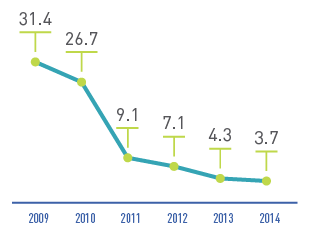
Overall, purchases of ROSSETI and its subsidiaries and dependent companies in 2014 were 37.3 thousand procurement procedures, totaling 319.9 billion rubles, exclusive of VAT, while the economic effect of competitive procedures in 2014 was 5.3%, or 17.9 billion rubles, exclusive of VAT.
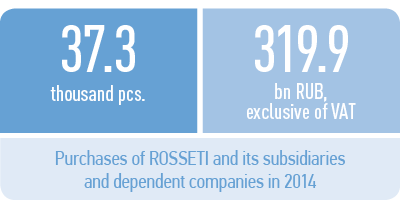
Cost Breakdown by Activity in 2014, %
The main share (32%) accounts for rehabilitation and technical upgrading of electric grid facilities
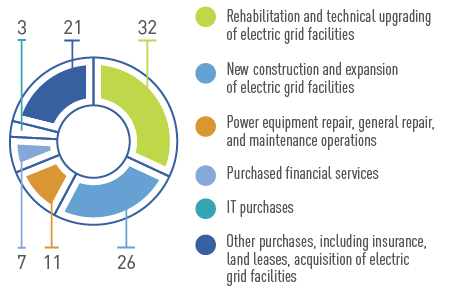
Regulated Procurement Procedure Breakdown by Purchasing Method in 2014, %
The main share (57%) accounts for public competitive bidding.
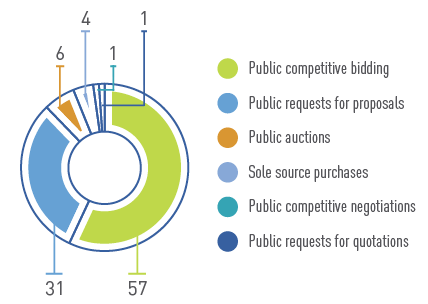
In addition, the economic effect obtained at the planning stage with a 10% and 30% cost reduction for large items covered by the 2014 consolidated capital investment program (without FGC UES) totaled 12.7 billion rubles, exclusive of VAT, or 3.6%.
Therefore, the total economic effect with savings arising from procurement planning reached 30.6 billion rubles, exclusive of VAT, or 8.8%.
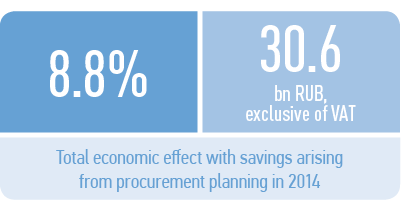
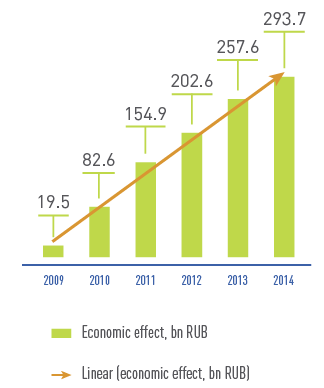
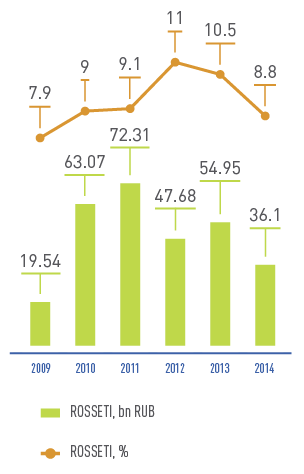
As part of implementing the Russian President’s instructions and the ensuing instructions issued by First Deputy Prime Minister of the Russian Federation Igor Shuvalov with respect to introducing a system of companies’ economic performance indicators, the Company’s Board of Directors approved the Technique for Calculating and Evaluating the Achievement of the KPI “At least 10 percent annual reduction of per-unit purchase costs related to goods (work, services) within three years in real terms in 2010 prices” and specified the corresponding KPI for senior managers of the Company and its subsidiaries and dependent companies.

In the reporting period, the Company continued its recent work on entering into long-term (three-year) contracts and framework agreements with manufacturers of basic electrical equipment.
Guaranteed Transparency
In 2014, ROSSETI and its subsidiaries and dependent companies received the highest award in the National Procurement Transparency Rating of Contracting Public Entities
Cooperation with small and medium-sized businesses
In 2013, ROSSETI joined the Working Group of the Agency for Strategic Initiatives for the development and implementation of the Road Map “Expanding Access of Small and Medium-Sized Businesses to Purchases of Infrastructural Monopolies and Government-Linked Companies.”
In May 2013, the Russian Government approved the Road Map “Expanding Access of Small and Medium-Sized Businesses to Purchases of Infrastructural Monopolies and Government-Linked Companies.” To date, ROSSETI has implemented all mechanisms and measures that could be carried out by the Company under the Road Map.
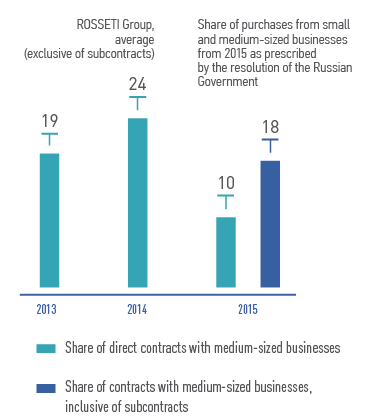
In the reporting year, small and medium-sized businesses won 24.1% of procurement procedures (compared with 19% in 2013).
Each of 15 subsidiaries and dependent companies has established a deliberative body responsible for public procurement audit, approved a partnership program, and included in its contracts the provisions giving preference to small and medium-sized businesses in accordance with the Resolution of the Government of the Russian Federation “On the Particularities of Small and Medium-Sized Businesses’ Participation in the Purchases of Goods, Work, and Services by Specific Types of Corporate Entities.”
In 2014, an electronic trading floor, which is primarily intended for small purchases, came into test operation. The trading floor provides maximum transparency and accessibility for procurement procedures, especially for small and medium-sized businesses. The trading floor is made attractive by providing minimum fees for participation in procurement procedures, and fees are payable only by the winning bidder while the other bidders pay no fees.

In December 2014, the Russian Government adopted the Resolution “On the Particularities of Small and Medium-Sized Businesses’ Participation in the Purchases of Goods, Work, and Services by Specific Types of Corporate Entities.” ROSSETI incorporated the provisions of the Resolution into the regulations and orders governing the procurement activities of its companies, including the Procurement Regulations.
Under the Strategy for Development of the Electric Grid Sector of the Russian Federation, the Company should perform methodological and coordinating functions, including with respect to its procurement policy
In this context and under the Road Map, the Company’s priorities are as follows:
- formulate the uniform Procurement Regulations for electric grid companies
- create a common information space for procurement.
Anti-Corruption Policy
Large-scale legislative changes in regulation of anti-corruption efforts, organizational-structural changes in the distribution grid resulted in development of a single strategic document – Anti-Corruption Policy of ROSSETI and its subsidiaries and dependent companies, which defines the common approach of the Group to compliance with requirements of the Federal Law “On Combating Corruption”, article 13.3 273-FZ, related to development and implementation of actions to prevent and combat corruption
Priorities of ROSSETI Anti-Corruption Policy
- evaluation of corruption risks
- detection and settlement of conflict of interest
- development and implementation of standards and policies aimed at fair operation support
- consideration and settlement of information on potential facts of corruption
- legal education and establishment of the basis for law-abiding behaviour of employees
- consulting and training of company employees
- internal control and audit
- actions to combat and prevent corruption in cooperation with counterparties
- interaction with state supervising authorities
- cooperation with law enforcement agencies in the sphere of combating corruption
- participation in joint initiatives to combat and prevent corruption
While implementing the anti-corruption policy, ROSSETI actively cooperates with state authorities and ensures publicity of its anti-corruption actions. The company builds relations with partners, counterparties and third parties in accordance with anti-corruption principles, implements competitive bidding, being guided by objective criteria in sourcing, engages in awareness raising, etc.
A lot of efforts in ROSSETI are spent on establishment of transparent business standards in the industry. Thus, a unique automated system – “Analysis and Collection of Data on Beneficiaries” – has been created in the company.
The system makes it possible to collect data from many sources into a single information space, having provided inspection of completeness and validity of data on legal entities and individuals – data on founders, owners, validity of the official legal address, data on Tax Payer ID, Primary State Registration Number of a counterparty, including a potential one. Besides, the system makes it possible to obtain data on a legal entity director, his or her business reputation, level of reliability, affiliation with the black list of suppliers/counterparties, instituted enforcement proceedings against counterparties, as well as to check his or her Tax Payer ID, passport data, address of residence, to detect criteria of affiliation, conflict of interest, pre-conflict situation and other abuse.
ROSSETI declares data on income, expenses, property and material obligations of Company’s executive arm heads and top management of Subsidiaries and Dependent Companies, including their immediate relatives. This work includes generation, analysis, processing of information, as well as its submission to external controlling agencies.
The ROSSETI Group has developed and approved the List of Anti-Corruption Actions that includes a whole complex of measures and policies with a procedure of their performance. All of this imposes special obligations upon ROSSETI to build a single vertically integrated system of Anti-Corruption Policy implementation in the Group, the controlling shareholder of which is the government.
In order to implement the state policy on combating and preventing corruption, on September 23, 2014 ROSSETI joined the Anti-Corruption Charter of the Russian Business. After joining the Charter, ROSSETI introduced the anti-corruption program and other measures of anti-corruption and corporate policy aimed at fair and open business into the practice of corporate governance.
For successful implementation of the Charter provisions ROSSETI actively participates in the work of the Expert Group at the United Committee of the Chamber of Commerce and Industry of the Russian Federation, specially established for development of appropriate organizational, methodological and information guidelines.
In the process of anti-corruption work ROSSETI:
1. Participates in operation of the Expert Group of the Interdepartmental Working Group on Combating Illegal Financial Operations at Federal Financial Monitoring Service. Thus, for example, to disclose the structure of counterparties’ owners, including beneficiaries (the end ones as well), the issue of a missing proper mechanism for identification of beneficiaries in part of validation of data on legal entities and individuals was presented to the members of the Expert Group of the Interdepartmental Working Group, which resulted in consideration of this issue in the Presidential Commission of the Russian Federation on Issues of Fuel and Industry Complex Development Strategy and Environmental Safety.
Therefore, under conditions of deoffshorization and combating money laundering, the governmental policy aimed at reduction of corruption risks may be secured with inclusion of a mechanism of proper identification of beneficiaries in regulatory acts, to avoid risk of invalid data submission and personal data processing
2. In order to detect and eliminate various barriers for development of the distribution grid, also in part of exclusion of instances of federal law violations during construction, reconstruction and operation of power facilities, ROSSETI participates in the interdepartmental working group at the Office of the Prosecutor General of the Russian Federation, which considers legal issues of ensuring business transparency, including elimination of conflicts of interest, affiliation and other abuse related to the position held:
- establishment of definitions (definition of the term “business transactions”);
- establishment of the public legal obligation of company’s counterparties to disclose information in respect to the entire chain of owners, including beneficiaries (end ones as well)’
- no regulatory and legal recording of the obligation to identify the chain of counterparties’ owners, including beneficiaries (end ones as well);
- elimination of the risk to violate the law in the sphere of procurement, anti-monopoly law and rights of legal entities in connection with establishment of excessive requirements to procurement procedure participants by the customer as natural monopoly.
On the basis of submitted materials the Office of the Prosecutor General of the Russian Federation sent inquiries to the Federal Anti-Monopoly Service of the Russian Federation, and answers received have determined the future mechanism of operation.
Moreover, ROSSETI also actively cooperates with the Chamber of Commerce and Industry of the Russian Federation and the All-Russia People’s Front – on the issue of establishment of a transparent procurement system, and many other public associations.
The main objective of measures executed by the company is to establish an environment that would minimize the manifestations of corruption. Successful resolution of this objective directly impacts business reputation of the Company, its perception by the partners and results of business operations
Achievements in IT (Information Technologies and Communications)
Reliable power supply to consumers, effective distribution grid management, formation and development of smart networks are also based on using state-of-the-art telecommunications and information technologies. For these purposes in 2014 ROSSETI continued to implement the “Strategy for Development of Company and Its Subsidiaries and Dependent Companies Development in Information Technology, Automation and Telecommunications Until 2016” developed and approved by the Board of Directors (ITT Strategy), as well as ITT Strategies in subsidiaries of the Company: IDGC of Volga, IDGC of Northern Caucasus, IDGC of North-West, IDGC of Siberia, IDGC of Urals, IDGC of Centre, IDGC of Center and V olga Region, IDGC of South, Tyumenenergo, Yantarenergo, LENENERGO, MOESK, Kubanenergo.
The strategy in the field of information technology, automation and telecommunications is first of all aimed at improvement of automation level of key processes of the ROSSETI Group, in particular, development of operational process control.
In this regard in 2014 within the framework of ITT Strategy implementation the priority was given to the following actions:
- ensuring observability of key power facilities condition (by development of telemechanics and telecommunications systems);
- development of distribution grid dispatching control and situation management systems;
- development of automated control systems for key business processes of the ROSSETI Group (also in compliance with the requirements of the Ministry of Energy of the Russian Federation).
To optimize business processes, in 2014 centralization of control and support of key business aspects of the ROSSETI Group was completed. Within this work:
- a single data transmission network was arranged and commissioned to provide access of the Subsidiaries and Dependent Companies to information systems of the Data Processing Center. Currently operation of centralized information systems is organized on its basis: Automated Network and Managerial Accounting Collection, Consolidation and Analysis System (ANAS), Automated Receivables Management System and others;
- a single information space of managerial document circulation has been established in ROSSETI and Subsidiaries and Dependent Companies, making it possible to formalize processes of joint operation with documents, to issue instructions and monitor their performance in a centralized manner.
- a single electronic trading platform for ROSSETI Subsidiaries and Dependent Companies has been created to ensure a common procedure for various procurement in electronic form;
- the ROSSETI Corporate Portal has been established, with functions to book meeting rooms, a phone directory, pass ordering function, information fund and working areas of ROSSETI subdivisions;
- a single Automated Investment Planning and Reporting System of ROSSETI Subsidiaries and Dependent Companies has been introduced;
- systems of HR, business and tax accounting have been deployed in the ROSSETI branch – Technical Supervision Center;
- ANAS subsystems development has been finalized on procurement activities, management of production assets, development of corporate and technological automated control systems, HR policy and organizational development, investment activity, capital construction. A tool has been developed to automatically download information from various accounting systems of Subsidiaries and Dependent Companies/branches, as well as an analytical tool for reporting analysis has been provided to users;
- within ANAS development, realization of projects has started to create centralized automated systems of the ROSSETI Group financial reporting (IFRS) consolidation; business planning of the ROSSETI Group; R&D management in Subsidiaries and Dependent Companies, as well as network connection, transmission and accounting of energy of the ROSSETI Group;
- ROSSETI transition to its internal corporate telephony system has been completed;
- a system of remote access to corporate applications on the basis of Citrix software has been established. Protection of remote connection with the help of personal security certificates has been realized, as well as possibility to access systems from various platforms (IOS, Android, Windows);
- a set of documents has been developed and approved that regulate functioning of ROSSETI IT Complex, such as Technical Policy on Telecommunications in ROSSETI and Subsidiaries and Dependent Companies, as well as the Standard “Software of Information and Computation Complex of Energy Accounting System with Remote Data Collection”.
In order to ensure transparency of ITT Strategy realization, a score methodology for achieved results has been introduced into the updated "road map": each project has been evaluated in terms of scope of functions that it helps to automate
At the same time calculation of automated functions scope is transparent and uniform for all participants of the process.
ITT operation planning in ROSSETI Subsidiaries and Dependent Companies in 2014 was based on the developed methodology for comparative analysis of specific costs (benchmarking) on certain ITT activities. Activation of work on bottlenecks detected in process of analysis made it possible to cut operation costs by more than 200 M RUR.
In process of ITT Strategy realization the transition to telecommunications services, IT-infrastructure managed in a centralized manner has continued. Such transition is a global practice and makes it possible to create a more efficient ITT structure preserving low level of costs for its maintenance.
In 2015 it is planned to continue realization of the Strategy both in ROSSETI and in its Subsidiaries and Dependent Companies. At the same time the main focus in ITT activities of the ROSSETI Group will be on ensuring reliable operation of ITT systems with account of minimization of costs necessary to develop and operate information technologies and telecommunications.
 Affordability
Affordability
Ensuring affordability of infrastructure and establishment of conditions for economic growth
Achievements of ROSSETI Subsidiaries and Dependent Companies in the field of network connection in 2014
Achievement of target parameters determined by the Road Map "Enhancing the Affordability of the Power Infrastructure" – key priority of Subsidiaries and Dependent Companies of the Company in the field of network connection
In accordance with the Strategy of Distribution Grid Development the ROSSETI Group has identified achievement of target parameters identified by the Road Map “Enhancing the Affordability of the Power Infrastructure” approved by the order of the Government of the Russian Federation on June 30, 2012 No.1144-r as the key priority in the field of network connection.
Results of the strategic initiative on power infrastructure affordability are aimed at creation of a favourable business climate in the territory of responsibility of the ROSSETI Group and improvement of quality of technical connection services, such as:
- reduction of timing and stages for connection of applicants’ power receivers to power infrastructure facilities,
- reduction of cost of connection to power networks.
In order to execute the directive of the Government of the Russian Federation dated December 12, 2013 No. 7464p-P13, the order of ROSSETI determined that implementation of the plan of actions (“Road Map”) “Enhancing the Affordability of the Power Infrastructure” was the priority activity for the ROSSETI Group. Standard documents on network connection have been approved, and actions to improve network connection procedure in ROSSETI Subsidiaries and Dependent Companies have been identified.
The following implemented actions shall be noted as the key ones:
|
1 |
Reduced timing for preparation and forwarding of draft network connection agreements has been set, compared to regulatory legal acts (up to 10 days at the norm of 15 days for applicants with maximum capacity of up to 150 kW inclusive and up to 20 days at the norm of 30 days for applicants with maximum capacity from 150 kW to 670 kW, inclusive). According to the 2014 results, in IDGC of Centre, MOESK, IDGC of Volga, IDGC of South, IDGC of Northern Caucasus, TDC in average the actual timing of draft agreement forwarding was below the specified timing norm |
|
2 |
Reduced necessary number of visits has been set for applicants with maximum capacity of power receivers of up to 150 kW inclusive, to a grid organization of up to three visits, compared to available practice of four |
|
3 |
Reduced timing of grid organization availability has been set for technical connection of applicants, the maximum capacity of power receivers of which makes from 15 to 150 kW (up to 90 days at the norm from 120 to 180 days). In 2014 considerable results on reduction of timing for performance of actions on network connection agreements were achieved in IDGC of South, IDGC of Northern Caucasus, Tyumenenergo, IDGC of Centre, IDGC of Center and Volga Region |
|
4 |
The extended list of quantitative parameters of ROSSETI Subsidiaries and Dependent Companies has been approved for realization of actions of the Road Map from 2014 to 2017, including item-by-item synchronization of investment programs of Subsidiaries and Dependent Companies and patterns of network development in constituent entities of the Russian Federation, as well as the share of network connection agreements without capital costs, the share of agreements with untimely fulfilment |
The result of actions on power infrastructure affordability in general across the ROSSETI Group was reduction of timing of network connection from the agreement to the act for the category of applicants with the maximum capacity of power receivers of up to 150 kW by 35 % compared to 2013.
Most efficient Subsidiaries and Dependent Companies, where reduction of network connection timing made more than 50%, were IDGC of Volga, IDGC of South, Tyumenenergo, IDGC of Siberia and IDGC of Center and Volga Region
To continue the systemic work of ROSSETI on enhancing power infrastructure affordability, the resolution of the Board of Directors dated December 19, 2014 (minutes dated December 22, 2014 No.174) approved the plan of actions of ROSSETI to achieve key indices in part of network connection necessary to achieve the target rating of Doing Business in 2015 on “connection to a power supply system” parameter.
The plan of actions for 2015 provides for realization of the following parameters:
- execution of agreements with executive authorities of the constituent entities of the Russian Federation on allocation of land for construction of power facilities through a simplified procedure during network connection;
- execution of agreements with power sales companies in the territory of constituent entities of the Russian Federation for performance of inspections of meters by grid companies and distribution of power supply agreements to applicants;
- execution of an agreement with the Federal Environmental Industrial and Nuclear Supervision Service of Russia (Rostekhnadzor) to simplify the procedure of permission of power facilities established in process of network connection;
- performance of works related to network connection of applicants with power plants of 15–150 kW using its own resources.
In order to raise awareness of applicants of existing procedure of network connection, settlements of existing issues (differences) for performance of existing network connection agreements, the Company has planned for the first half of 2015 a series of open meetings with existing and potential applicants, with involvement of public associations and business community organizations, and summarization of open meeting results is planned for June 2015 in the format of panel discussions and round tables.
To involve authorities, representatives of public organizations and experts in the field of power engineering into discussion of relevant issues on power infrastructure affordability and exchange of the best corporate and regional practices, ROSSETI has planned for September 2015 the Third All-Russia Network Connection Forum.
Power infrastructure affordability
The road map on enhancing power infrastructure affordability has set as reference indices of successful realization of legislation reforms in the sphere of network connection for establishment of favourable business climate the rating "Doing Business" of the World Bank with the target reference point – inclusion of Russia into top-20 countries
Within the framework of performance of the Road Map on enhancing power infrastructure affordability, substantial amendments have been realized in 2014 with active participation of ROSSETI representatives as experts in normative regulation of the network connection procedure, as specified in the table below.
Development of Customer Portal
The main activity enhancing affordability of network connection services in part of reduction of connection stages at the corporate level is optimization of internal business processes, also by development of electronic forms of service via Internet.
The ROSSETI Group within the framework of realization of the Road Map “Enhancing Power Infrastructure Affordability” has established the electronic consumer support resource – ПОРТАЛ-ТП.рф.
|
Road Map |
Substance of amendments |
NCA |
|---|---|---|
|
item 9 |
The obligation of guaranteeing suppliers has been introduced to execute a power supply agreement (power sale and purchase) with consumers before completion of the network connection procedure |
Regulation dated February 10, 2014 No. 95 |
|
item 11 |
The procedure of reissue of documents has been introduced to confirm the fact of network connection and appropriate volumes of maximum capacity of the consumer + Standard forms have been approved: Act of Compliance with Technical Conditions, Act of Visual Inspection (Survey) of Power Plant, Act of Network Connection Completion, Act of Balance Delimitation and Act of Operational Responsibility |
Regulation dated February 20, 2014 No.130 |
|
item 19 |
The schedule of network connection cost reduction for consumers has been approved (from October 01, 2015 the network connection fee includes 50% of the investment component; since October 01, 2017 the network connection fee does not include any investment component) with compensation of grid organization costs, taken into account within the tariff for power transmission services |
No.83-FZ dated October 21, 2014 |
|
item 20 |
The procedure of compensation of lost income compensation to grid organizations related to network connection of consumers has been determined. Instruction to the Federal Tariff Service of Russia to develop and approve the methodology for determination of lost income of a grid organization from network connection activities |
Regulation dated June 11, 2014 No.542 |
|
item 20 |
Changes have been introduced into Basic Pricing Principles: the scope of lost income of the grid organization from network connection activities has been specified and detailed |
Regulation dated October 29, 2014 No.1116 |
|
item 5 |
It has been established that since March 01, 2015 power transmission lines with voltage class of up to 35 kV, as well as related electric grid facilities, for installation of which a construction permit is not required, may be installed on lands of state and municipal property without allocation of land plots and establishment of servitudes. |
Regulation |
|
item 37 |
The procedure of network connection of gardeners' non-commercial partnerships and individual applicants (consumers) in their territory has been identified |
|
|
item 39, stage 1 |
The procedure has been introduced to approve the indirect network connection of previously connected power receivers by the owner with the grid organization |
|
Official websites of Subsidiaries and Dependent Companies and their branches include interactive support, the main tools of which are the Internet Reception Desk and My Account. The number of applications via electronic form through Internet in 2013 was 24 K, which is twice more than the identical parameter of the previous period.
The following electronic services are realized at ПОРТАЛ-ТП.РФ, which make it possible to consumers to efficiently receive the necessary information on network connection procedure, including:
|
Information |
|
|
Feedback |
|
|
My Account |
|
|
Network Connection |
|
|
Necessary |
|
Further development of electronic support services at the Customer Care Portal (портал-тп.рф) is implemented in accordance with the requirements of the Uniform Customer Service Quality Standards approved by the order of the Ministry of Energy of the Russian Federation dated April 15, 2014 No.186, including expansion of My Account functionality, synchronization with My Accounts of lower level websites, development of an engineering calculator of connection cost, expansion of geographical coverage of the interactive map of supply centers of independent TGOs.
Improvement of service quality, provision of consumer satisfaction
In ROSSETI in 2014 the resolution of the Board of Directors dated June 17, 2014 (minutes dated June 20, 2014 No.158) approved the Policy on Society, Customer, and Government Relations of ROSSETI.
The Policy on Society, Customer, and Government Relations as the target reference point of consumer relations has identified introduction of a customer-oriented approach into business of grid organizations and raising trust of consumers
The main objective of the client-oriented approach is establishment of loyalty of service consumers to the organization due to affordability of services, quality care of customers and satisfaction of their shortand long-term needs.
The Policy on Society, Customer, and Government Relations of ROSSETI determines the following guiding principles:
- Provision of services quality and affordability
in accordance with the existing legislation of the Russian Federation- Sufficient awareness of consumers about the company and services
This principle prevents the need of consumer applying to the Company for reference information and consultations, and as a rule, transaction costs of the company- Territorial affordability and comfortable conditions of onsite service
Location of infrastructural elements of on-site service (customer service offices) provides for coverage of the area of responsibility of Subsidiaries and Dependent Companies and availability of service to customers- Affordability and efficiency of remote and electronic service
Electronic (interactive) service in Internet has convenient and high-speed access, interactive service interface and tools are ergonomic and user-friendly for consumers- Qualified service
Organization of all forms of service provides for high level of qualification and competence of company’s service personnel- Transparency of business processes of customer care
and impartiality in consideration of consumer complaints Business processes of customer service are formalized, described and transparent to ensure controllability and manageability of procedures of interaction with consumers
ROSSETI pays a lot of attention to enhancing affordability of network connection and creation of comfortable conditions for consumers, providing for development of complex service and introduction of new technologies. With this purpose they upgrade and equip the Customer Service Centers with state-of-the-art equipment, such as electronic queues, terminals for payment of services and self-service information terminals.
Currently the ROSSETI Group according to the Uniform Customer Service Quality Standards of grid organizations approved by the order of the Ministry of Energy of Russia dated April 15, 2014 No.186, actions are implemented to bring the customer service offices and their classification in compliance with the approved requirements.
As of the end of 2014 in the territory of service of the ROSSETI Group 986 service offices were functioning, out of them 300 were customer service centers, others – service stations opened on the basis of territorial subdivisions of Subsidiaries and Dependent Companies
In administrative centers of constituent entities of the Russian Federation within the territory of responsibility of the Group the on-site service is carried out in 69 customer service centers of enhanced comfort.
In 2014 services offices were created and opened after upgrade i Moscow, Troitsk (New Moscow), Sochi, Sovetsk (Kaliningrad region), Kashira (Moscow region), Revda (Sverdlovsk region) and Anapa (Krasnoyarsk Territory). On sites of customer service centers the consumer may submit an application for services, also for network connection, receive reference information and consultation on issues of network connection, power transmission and fiscal metering of power, leave a claim (complaint), receive information on activity of other power companies of the region.
In 2014 1.36 M people applied in person to the service offices of the ROSSETI Group, which is by 2% higher than the parameter of 2013
This growth first of all depends on enhanced territorial affordability and quality of on-site service for public in regions of ROSSETI Group service.
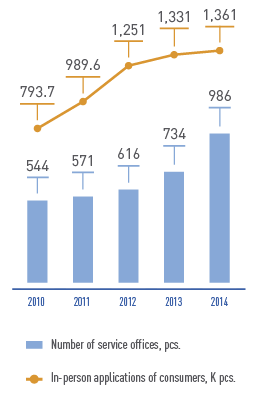
Remote customer service by phone in the ROSSETI Group is carried out mainly through common numbers of telephone centers of Subsidiaries and Dependent Companies and telephones of operative dispatching services of Subsidiaries and Dependent Companies.
The main tasks of the telephone centers are to receive and process incoming calls from service consumers on all issues of business of Subsidiaries and Dependent Companies, as well as address notification of consumers.
To minimize effects of process failures and efficient notification of public on time of emergency recovery works, especially in autumn and winter period, hotlines have been opened
Following the current trends of Internet technology use, enterprises of the ROSSETI Group pay a lot of attention to development of a uniform Internet portal for customer service and electronic customer care services on websites of Subsidiaries and Dependent Companies, therefore the number of applications in electronic form through Internet in 2014 was 44.7 K, which is almost twice more than the identical parameter of the previous year.
For the last 4 years the annual growth of electronic applications via Internet is 90% in average
The growth of applications was influenced by a combination of such factors as annual growth of Internet audience, especially its active part, spread of mobile and broadband Internet, affordability and convenience of services of the ROSSETI Group.
Through all channels of interaction with consumers in 2014 the ROSSETI Group received 3.5 M applications, which is 18% lower than the parameter of 2013
The factor analysis of applications shows that reduction is due to fewer complaints about poor quality of services (by 26%) and consultations (by 11.5%). The available trend confirms efficiency of implemented actions to improve quality and affordability of services, as well as information openness of the ROSSETI Group business for consumers.
